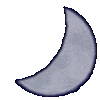The Circle of Light
Issue #1
Date: 13/4/2001

In this issue:
Chakras:
An Introduction
Animal Magick:
Blackbird and Antelope
The Power of Animals
Crystals
Pagan Band Review:
Inkubus Sukkubus
Slavic Paganism:
Broken Pysanky
Gods and Goddesses of Witchcraft:
Hecate
Body and Soul: Holistic Healing
Meditation:
Yoga
Horoscopes:
Horoscopes for August
Pagan News:
Wendy Rule
Your Say:
Submit Your Say
Submissions:
Submit Your Own Work





|
Chakras:
An Introduction
(c) Ryan Bennington 2001

Chakric studies have existed for quite some time, and many varying traditions have developed, however, I chose to speak of the
Shakta Tradition for it is the most reknowned.
Within every living body there is said to be a series of energy fields or centres of
Chaitanya (pure consciousness), which in traditional Tantric teachings are called
Chakras (Wheel) or Padmas
(Lotus). This subtle collective vital force which flows throughout our bodies is referred to as
Prana and the channels along which it flows, Nadis.
The Sanskrit word Nadi
translates from the root word Nad, which means "motion".
Nadis appear as tubular structures and are comprised of three layers, the
outermost layer names the entire structure. Each layer is located one inside the
other. The innermost layer is referred to as Sira, the middle
layer, Damani, and the outer, as mentioned
previously, Nadi. The body is filled with
innumerable Nadis, however, they are said to exist in numbers from 72,000 to
350,000.
These Nadis are said to originate from Kanda,
which is the junction where the Sushumna
Nadi (the
primary Nadi in the body which runs through the hollow cylindrical cavity of the vertebral column
and represents Agni or
fire) is connected to the Muladhara
or Root Chakra
(that is, just above the anus). This junction is thereby named Kanda-Mula
and assumes a somewhat ovular shape. This junction is regarded as a center of
the astral body, the root from where all the Nadis spring and carry Prana.
In the space outside the Merudanda,
(the actual vertebral column; Mount Meru is
symbolised by this and is the axis of the earth, and the abode of Lord Shiva) on either side of the
Sushumna are the two main secondary Nadis:
-
Ida
or Chandra (Moon) is located to the Left of Sushumna, it is of pale
colouring, usually white. It contains Apana
or Descending Vitality (Lunar Energy).
-
Pingala
or Surya (Sun) is located to the right, containing Prana
Lesser or Ascending
Vitality (Solar Energy) and is usually coloured fiery red.
Ida (also called Sasi, Lalanda and Pitryana) starts from the
right testicle, and Pingala (also
called Mihira, Rasana and Devayana) from the left testicle.
These Secondary Nadis meet the Sushumna Nadi at
the Muladhara Chakra and make a knot.
This junction is called Mukta Triveni. Ganga, Yamuna
and Saraswati dwell in Pingala, Ida and Sushumna. This meeting place is called
Brahma Granthi. These meet again at the Anahata and Ajna
Chakra (Heart and Brow Chakras respectively) where Ida flows through the left nostril and Pingala
through the right nostril.
Ida and Pingala indicate Kala (time
and death) and Sushumna swallows time.
Also within Sushumna there is also Vajra
Nadi, which is lustrous as Surya
with Rajastic qualities and within Vajra there is
Chitra (or Citrani) Nadi, it is of Sattivic nature and of pale colour as
Chandra. Within Chitra there is a very minute canal
called Brahmanadi, through which Kundalini
(when awakened) passes from Muladhara to Sahasrara Chakra (Root to
Crown). The lower extremity of Chitra Nadi is called
Brahmadwara (door of Brahman), through which Kundalini (cosmic
energy) has to pass to reach
Brahmarandhra (hole of Brahman), in the crown of the head.
In general Sushumna is called Brahma Nadi because Brahma Nadi is within Sushumna.
In the same way the canal within Chitra is called Sushumna because the canal is within Sushumna.
The junctions of Nadis with the Sushumna
Nadi are known as the Chakras or
Lotuses. Throughout the body, Six Major Chakras
exist. These Six Chakras are strung like pearls or jewels along the brilliant thin thread of the
Sushumna Nadi. Each
Chakra correlates to major nerve ganglia
(Plexus) branching forth from the Sushumna.
In addition to these Six arranged along the spine, there are also Chakras in the hands, feet, genitals, and so on. There are
Six Minor
Chakras thus there are Twelve (12) altogether. Each Chakra regulates a specific type of
Kundalini energy; collectively this energy is Prana.
Kundalini
is the cosmic energy and is symbolized by a female serpent coiled (Kundala means coil of
rope) and sleeping at the base
of the spinal column. This latent energy has to be aroused by meditation and yogic techniques, and made to
ascend the main spinal channel, trough the Chakras, up to Sahasrara
(Crown)
All Chakras are supported by the
vertebral column; the five regions of the spinal column -- coccygeal, sacrum, lumbar, dorsal and cervical
region. These areas correspond to the regions of the five Chakras: Muladhara,
Svadhishthana, Manipura, Anahata and Vishuddha.
And with accordance to
the Yogatattva Upanishad*, these
five parts of the body/Chakras also correspond to the five great or cosmic elements
-- earth, water, fire,
air, and space.
Each element in turn corresponds to a particular mantra
--
a "seed-vibration" or mystical syllable -- and a particular deity. Emphasis is also given to
Siddhis (supernormal powers) that can be attained through mastery of yoga and of the different elements.
| Chakra |
Position |
Petals |
Tattwa |
Element |
| Sahasrara |
Thousand Petalled-Lotus¹ |
Above head |
1000 |
Transcendent |
Transcendent Spirit |
| Guru |
|
Above head |
12 |
| Nirvana |
|
Crown |
100 |
Origin Of Mind |
Mind |
| Indu |
|
Forehead |
16 |
Buddhi |
| Manas |
|
Forehead |
6 |
Chitta |
| Ajna |
Guru's Command |
Brow |
2 |
Manas |
| Talu/Lalana |
|
Roof Of Mouth |
12 or 64 |
N.A. |
N.A. |
| Vishuddha |
Complete Purity |
Root Of Neck |
16 |
Space |
Elements |
| Anahata |
Unstruck Melody |
Heart |
12 |
Air |
| Hrit |
|
Heart |
8 |
N.A. |
| Manipura |
Fullness of Jewels |
Navel |
10 |
Fire |
| Svadhisthana |
Own Abode |
Near Genitals |
6 |
Water |
| Muladhara² |
Root Support |
Anus |
4 |
Earth |
¹ The
Sahasrara-Padma
or "Thousand
Petalled-Lotus", located at the very top of the head, is not a Chakra at all, but the summation of all the
Chakras. Apart from the Sahasrara, each Chakra is described by means of a whole lot of symbolic associations or correspondences. Each Chakra, as well as having a specific position in the physical body, element, mantra, and deity, also has
a corresponding colour, shape, animal, plane of existence, sense-organ, mantric sound, and so on.
Each Chakra also has a particular number of petals with
the Sanskrit alphabet on each petal. (all the 50
Sanskrit letters are on the 50 petals of the six Chakras (4+6+10+12+16+2). These letters exist
on the petals in a latent form and can be manifested and the vibrations of the Nadis felt during meditation.
Chakras are in the Linga Sarira (Astral Body), and cannot be seen by eyes, one can feel and
understand the Chakras during concentration and meditation only.
Sukshuma (subtle) Prana
(vital force) moves in the nervous system of the Linga
Sarira. Stoola Prana moves in the nervous
system of the gross physical body.
"The number of petals in each Chakra is determined by the number and positions of the Nadis
around the Chakra. From each Chakra a a particular number of Yoga Nadis crop up. The Chakra
gives the appearance of a lotus with the Nadis as his petals. The sound is produced by the
vibrations of the corresponding Sanskrit letter. The Chakras with their petals hang downward
when Kundalini is at the Muladhara Chakra. When it is awakened, they turn Toward
Brahmarandhra. They always face the side of Kundalini."
²
In the lowest chakra, the Muladhara, at the base of the spine, there lies the
Kundalini-Shakti, the latent consciousness-energy, the microcosm of the cosmic creative
Shakti. When this is aroused, it can be made to ascend the
Sushumna, either activating or dissolving (depending on the yogic tradition) each Chakra in turn, until it reaches the highest or Crown Chakra, the
Sahasrara, where dwells the Godhead or Supreme Shiva
(Paramashiva). As the Kundalini-Shakti unites with
Paramashiva, the original transcendent equilibrium is restored, and the yogi returns to the state of oneness with the Absolute.
The Brahma-Upanishad* mentions the four "places" occupied by the
Purusha (soul): the Navel,
Heart, Throat, and Head. Following common
tradition, each place is characterised by a particular state of consciousness:
The Navel (or the eye) - waking consciousness
The Heart - dreamless sleep
The Throat - dreaming
The Head - the "fourth" or transcendent state.
From this, we can see that the Chakras represent not only particular parts of
our physical bodies, but also particular parts of our consciousness.
These four states, originally referred to in the Mandukya
Upanishad*, are identified with the
Gods Brahma, Vishnu, Rudra (a derivative of Shiva) and
Akshara (The Indestructable).
* Upanishads are Philosophical Texts
Chakras function as pumps or valves which regulate the flow of Prana through our selves; physical and astral. The functioning of the Chakras reflects decisions we make concerning how we choose to respond to conditions in our life. We open and close these valves when we decide what to think, and what to feel, and through which perceptual filter we choose to experience the world around us.
Theoretically speaking, Chakras are the means through which a physical body communicates with its aura and vice-versa. It is said that they are more dense than Auras, but not as dense as the physical body. However, with the same mannerism as auras, they interact with the body through subconscious means, though, unlike auras, they interact with the physical body through two major vehicles:
[1] The endocrine system
[2] The nervous system.
All the functions of the body are under the control of the Chakras in Sushumna.
The Chakras are centres of Pranashakti, Shakti as cosmic energy in latent shape, the presiding
Devatas of which are the names for the Universal Consciousness as it manifests in the form of
these centres.
A particular Tattwa (Element) preponderates at every Chakra. In every Chakra a certain animal is represented. It denotes that the center has
the qualities, Tattwas or Gunas of that particular animal. Some Hatayogis say that there are 21 minor Chakras beside the 13 major Chakras, others say
that there are 49, while the ancient Yogis taught that there are 144 Chakras.
NOTES
-
The idea of Prana and Nadis appear in the earliest Upanishads*
(7th-8th century b.c.e.) The heart was said to be the centre of the 72,000
Nadis, and the place into which the senses are withdrawn during sleep. But it was only in the later Upanishads - the earlier of which were
composed somewhere between the 2nd century b.c.e. and the 2nd century c.e. -
that reference is first made to basic Tantric concepts such as chakras, mantras,
and so on.
-
The modern use of the term Chakra as a "wheel" claims that this is how they appear to yogic and clairvoyant perception, but there is no evidence that the Tantrics considered or even experienced the Chakras in this manner.
Blessed Be,
Ryan

Email Ryan at:
somewhat_damaged@graffiti.net
(c) Ryan Bennington 2001
|







